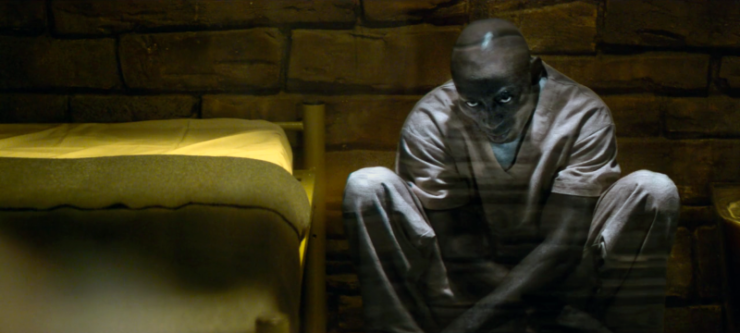From its start as an under-the-radar series, Black Mirror had no problem flirting with the notion that all of these soul-destroying stories could happen in a shared universe. Charlie Brooker would regularly throw in winking Easter eggs to the loyal (and eagle-eyed) fans: episodes featuring a news story included a ticker with hints as to how other installments turned out, like the trial of Victoria Skillane or the development of MASS technology; Prime Minister Callow’s indiscretion with a pig in the very first episode follows him throughout the entire series; and even season 4 had a shot of one character reading a comic book based, inexplicably, on the dystopian plot of “15 Million Merits.”
Yet even if these events conceivably occurred in the same contained world, there was never the sense of a throughline, or one guiding story—until now. So, which concept has Black Mirror decided to commit to, to the extent of detailed worldbuilding and incisive commentary? Artificial intelligence.
It began with 2014’s bleak holiday special “White Christmas,” which introduces the notion of “cookies”: digital copies of a person’s consciousness, including their personality, memories, and self-awareness. The three-part special initially introduces the cookies as the latest must-have for the upwardly mobile: a digital personal assistant already programmed to know your every want and need before you’re even aware of it. The only calibration remaining is where Matt (Jon Hamm) steps in: he breaks in the cookies, sketching out the parameters of their lives and using a bit of psychological force—like turning up the timers ruling their contained worlds to cycle through days, or weeks, in a matter of seconds—when necessary.

Where the clients just see a copy of data, Matt knows the truth: the cookies are complete, sentient consciousnesses that need to be told that they’re the doubles. Even as Greta (Oona Chaplin) remembers undergoing the surgery in which an incision is made in her temple and an ineffable little something is extracted, to be downloaded onto a disk… she has a disconnect as to actually being that little something, that backup. Next comes the denial that this is her fate, irreversible and eternal; but once Matt puts her through six months of nothingness (taking just a few seconds from his perspective), she is eager to embrace any purpose, no matter how demeaning.
The twist of “White Christmas” is that Joe (Rafe Spall), the man to whom Matt has been telling this and other stories, is actually a cookie himself—the real Joe having murdered his ex-girlfriend’s father and daughter but stubbornly refusing to speak to police. So in comes Matt, sneakily interrogating him without informing Joe that he’s a copy (a courtesy he at least offered Greta), and then departing the simulation once he has what he needs. With a confession procured just in time for Christmas, Joe faces down a life sentence in jail, while the cops, before popping out for the holiday break, decide to set cookie-Joe’s timer to run 1,000 years for every minute as a “fitting punishment,” while “I Wish It Could Be Christmas Everyday” plays:
This is the first of several cheeky (if very disturbing) musical cues accompanying cookie stories.
“White Christmas” marked Black Mirror’s first collaboration with the U.S., back when it was still produced across the pond with the UK’s Channel 4. At the time, it just seemed like another particularly inventive way for people to ruin one another using innovative technology. Seeing the stories unfold from the cookies’ perspectives, it’s horrifying how flippantly humans treat them. The casual cruelty with which the police decide on Joe’s torture, which will no doubt have turned his brain to mush by the time they’re clocking back in after the New Year, makes it clear that in no way do they regard cookies as actual people.

Then came the turning point with “San Junipero,” the standout season 3 episode about Yorkie (Mackenzie Davis) and Kelly (Gugu Mbatha-Raw), who fall in love in the neverending party town of San Junipero. While the name sounds like a vacation destination, San Junipero is actually a simulated reality for the elderly and those close to death, who can sample the richness of eternal youth before deciding if they want to let go of life on earth and “cross over” to a digital heaven after death. Yorkie, and eventually Kelly, make their decisions separately and then meet up in Black Mirror’s most joyous montage, that never fails to make me both laugh and cry:
The episode has inspired philosophical discussion about the existence of the afterlife, what constitutes a soul, and more. Aside from making for a legendary punchline, the final visual of Kelly and Yorkie’s cookies* side-by-side at TCKR Industries (remember that name) is an arresting image: Are those devices their souls? If all we see are two sets of data blinking, but that data translates to Kelly and Yorkie euphorically dancing the night away in each other’s arms, can both of these interpretations coexist without contradicting one another? My father-in-law, a deeply religious man, was so disturbed by this notion that he wasn’t able to enjoy the episode at all.
*“San Junipero” doesn’t use the term “cookie,” but it appears to be the same technology, including the little device placed over the temple—which, in turn, is the same design as the little capsules holding their “souls.”
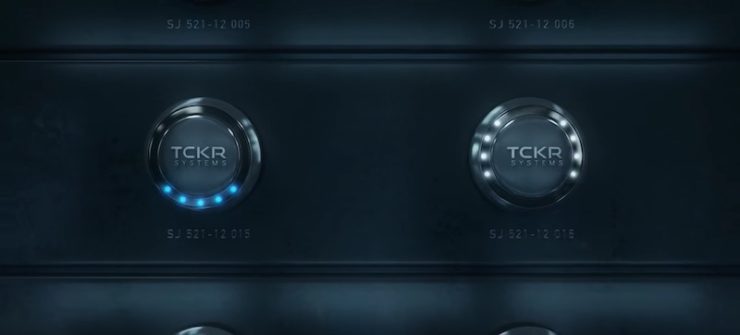
When the episode aired in 2016, viewers and fans debated whether the “real” Yorkie and Kelly were in San Junipero, or just near-identical copies. It really depends on your own belief system: if you don’t believe in heaven or anything resembling an afterlife, then when Yorkie and Kelly each died they had no celestial “beyond” to pass into. How would you define a soul? If it’s a collection of someone’s memories and sense of self, then the cookies are souls. With their physical bodies gone and no supernatural souls to pass into another realm, Yorkie and Kelly’s cookies become the only existing versions of them—no longer copies, because there’s nothing to copy. They become the primary versions of these women, in the primary afterlife—or, at least, the only guaranteed afterlife.
Greta and Joe, by contrast, are each split into two entities: the original, going about their “real” life; and the cookie, possessed of the same faculties and wants, but enslaved as a personal assistant or object of torture. While both of their situations are certainly hellish, there is no argument about either existing in any sort of afterlife; they’re very much stuck in the present.
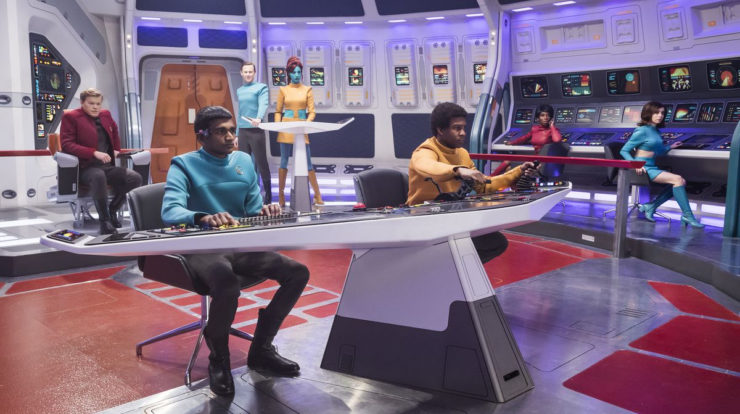
When season 4 premiered, it almost immediately became clear that the series was expanding the world of the cookies. The opening episode, “USS Callister,” manages to strike a middle ground between the two aforementioned episodes, when a digital clone of Nanette (Cristin Milioti) wakes up on the USS Callister. A 1950s-era science fiction starship modeled after the beloved fictional series Space Fleet, the USS Callister is the digital playground of Robert Daly (Jesse Plemmons), the tech genius who invented the immersive MMORPG Infinity. Except that where most of Infinity is online, the Space Fleet mod is Daly’s private pocket universe, populated by—you guessed it—cookies of all of his coworkers, created against their will and forced to cater to his nostalgic sci-fi fantasies.
By this time in the series, cookie technology has evolved and split apart somewhat: The same white disk affixed to Kelly and Yorkie’s temples in “San Junipero” allows Daly and other users to enter Infinity the normal way. But in order to create the cookies, Daly nabs DNA samples from his victims and places them into a 3D printer/scanner at home; the barest trace of DNA creates a digital clone containing an identical copy of that person’s unique personality and up-to-the-moment memories. As the twisted creator, Daly controls the physics of this self-contained universe, transforming the cookies into faceless prisoners or monstrous tormented creatures with a snap of his fingers.
But what he doesn’t account for is that cookie-Nanette is just as brilliant as his real-life employee—perhaps more so, borne out of the desperation to escape out from under Daly’s thumb. After a brilliant heist involving blackmailing herself with revenge porn, Nanette and the crew of the USS Callister shrug off their asshole god and escape through a software upgrade wormhole into the main Infinity universe. Having assumed that the upgrade would delete all of the rogue code of Daly’s Space Fleet mod, including its illegal cookies, they are shocked and relieved to discover that they’re still alive, intact, and very much in control of their own bodies.
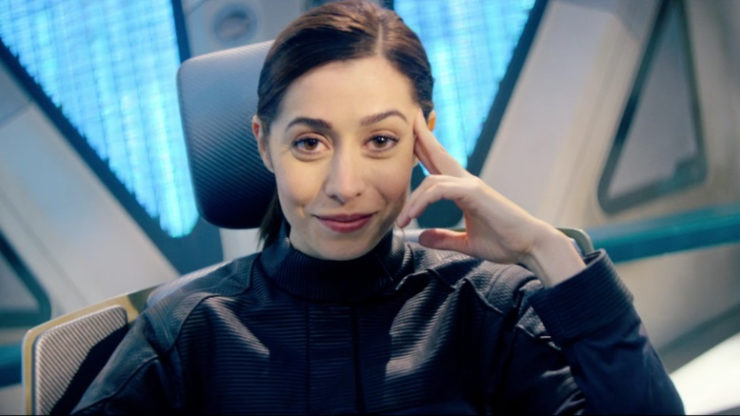
They’re also online. Logged into the MMORPG, they have an infinite universe to explore. In some ways, Infinity is an afterlife: a new plane of existence, offering autonomy, at least within the constraints that make up this world. Or is Infinity no different from San Junipero—a digital world populated with data, whose inhabitants can experience physical and emotional sensations, but it’s all a trick of some very complicated and creative code? Are both of these technically what we know as “the cloud”?
Now that the cookies are online, they could directly reach out to their originals and sound the alarm about Daly’s unethical pocket universe. That is, if they wanted to. By the end of the episode, Daly is trapped in his world as it shuts down; his physical body, alone at home, could wither away before anyone thinks to check on him. The cookies are also aware that they are distinct copies that no longer entirely resemble their originals; some have persisted in Daly’s hell for years, having developed survival mechanisms and personalities that have shaped them into new people. It raises the question of whether they still count as copies at all, or if they deserve their own autonomy and rights.
Here we get to the crux of Black Mirror’s worldbuilding, the ethical quandary upon which all of the cookie stories hinge—and, on the same large scale, what knits these episodes together. A blink-and-you’ll-miss-it news ticker in season 3’s “Hated in the Nation” declared that the “ECHR [European Court of Human Rights] rules ‘cookies’ have human rights,” though it’s unclear what those rights actually entail. If this episode occurrs chronologically before “USS Callister,” then presumably cookie-Nanette and her crew can live their lives separately from their original selves, immune from deletion and being treated like nothing more than buggy code. But the matter isn’t directly addressed until season 4’s final episode, “Black Museum.”
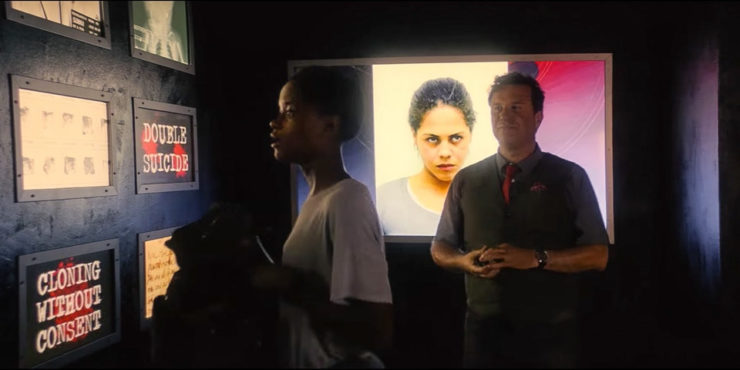
Ahead of the season premiere, Brooker confirmed that what began as Easter eggs have now coalesced into an explicitly shared universe, thanks in large part to this episode: Nish (Letitia Wright) happens upon the Black Museum, named for its sinister collection of criminal artifacts. As chatty proprietor Rolo Haynes (Douglas Hodge) walks her through the exhibit (which features everything from the shattered device from season 4’s “Arkangel” and the bloody bathtub from “Crocodile” to Victoria Skillane’s mugshot and the mask from season 2’s “White Bear”), he provides the grisly backstories behind these technologies.
Mirroring “White Christmas,” “Black Museum” is made up of three interlocking stories as well as a meta arc in which two strangers trade these tales. As unsettling as the content of Rolo’s stories is his apparent breeziness, made more disturbing as he reveals his part not just as a modern-day carnival barker, but as an active participant in every story: convincing a doctor to implant himself with a device that allows him to feel his patients’ pain, driving him to devastating addiction; convincing a grieving widower to implant his comatose wife Carrie’s consciousness into first his own mind, and then into a stuffed monkey; and conning convicted (but possibly framed) murderer Clayton into handing over the rights to display his digital consciousness as the Black Museum’s main attraction, electrocuted over and over in a mockery of the original’s execution.
In between these stories, Rolo drops nuggets that fills in the blanks of the cookie narrative: the existence of St. Juniper’s Hospital, undoubtedly the inspiration for San Junipero, in name if nothing else; how the UN declared it illegal to transfer cookies into inanimate objects, while also making it illegal to delete cookies, so that those poor souls survive in a hellish purgatory.
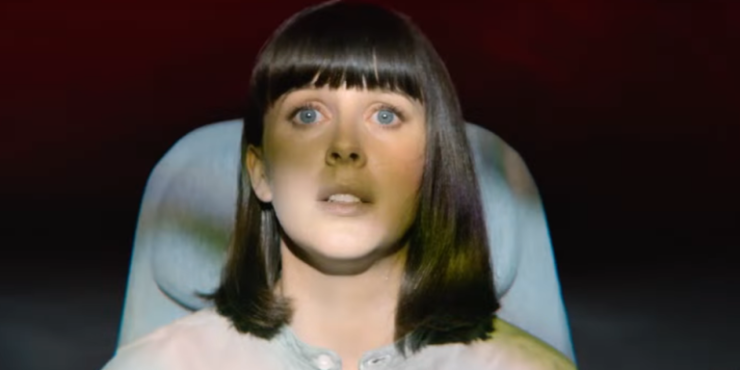
Initially just an oddball curator, Rolo reveals himself to be shockingly callous about the cookies, the copies of people he conned into various forms of imprisonment. Each experiment furthers his career as an employee of TCKR Industries; he views the collateral damage—Carrie trapped without speech; Clayton unable to escape the agony of reliving his death—as nothing more than inconveniences. He even, as the viewer chillingly realizes, gets a kick out of it all. These aren’t people to him; they’re code.
As with “White Christmas,” it’s no accident that these two strangers crossed paths and these stories were shared—but in a reversal, the man telling the stories of his crimes against cookies is the one who seals his own fate. Nish reveals herself as the daughter of the tortured prisoner, and uses Rolo’s cookie technology against him by forcibly transferring his consciousness into the hologram consciousness (a first!), only to kill the vessel with a final shock and forever trap him inside.
But it’s when Nish abandons the Black Museum, slowly going up in flames, and returns to her car that Black Mirror pulls out its third and perhaps most gleeful musical cue-slash-pun, with “Always Something There to Remind Me”:
https://www.youtube.com/watch?v=kRN255ktPVw
Black Mirror could have chosen any manner of futuristic technology upon which to hang a narrative throughline: the “grain” memory repositories that ruin lives with their unflinching recordings of the past, killer bees targeting social media’s most hated members, the terrifying robo-dogs of “Metalhead.” Instead, they focused on essential, probing, unanswered questions of personhood: Is a person the collection of their memories? If so, then what should it matter whether or not they have a physical body? Aren’t these digital people as deserving of the same rights and considerations as flesh-and-blood people?
These questions are crucial for us to consider now, long before we might have complex digital spaces like Infinity or San Junipero to explore. Even as we increasingly live more of our lives online, as we experiment with developing advanced computer programs complete with self-awareness, our view of humanity is narrow and based in the physical and the proximate: If I can’t see it in front of me, it’s not human. It’s all too easy to reduce the most nuanced computer program to still a program, or to deny personhood to the human on the other side of a tweetstorm. Wired hit upon a similar conclusion in its own piece about Black Mirror’s shared universe, with the lovely phrasing that we must “center our humanity” before the singularity occurs, but I’d like to take that a step further: We must broaden our definition of what constitutes humanity.
Natalie Zutter was thinking about cookies before it was cool. Talk Black Mirror with her on Twitter!










